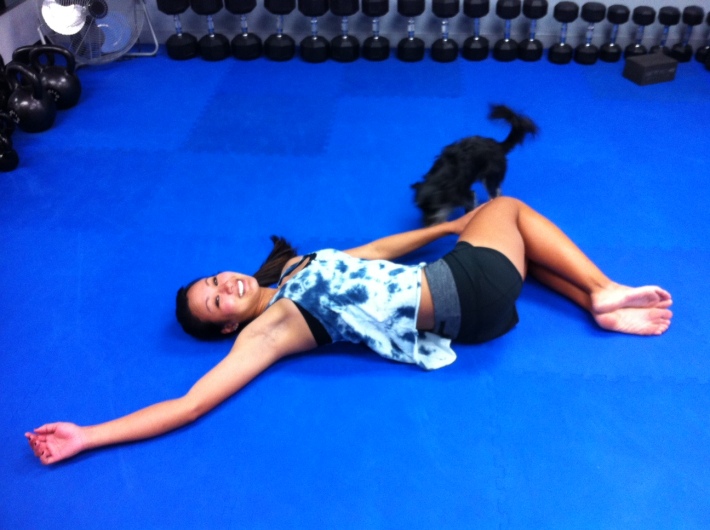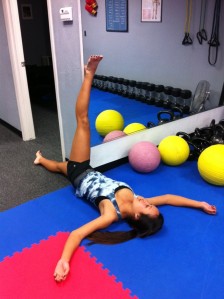As a runner, if you can consistently do these 3 fundamentals, then you will be ahead of most people’s entire stretch routine.
The stretches below are definitely not a complete program, but they are the missing link to the most common weaknesses I find in runners, and if you only have a short time, these will give you the best bang for your buck.
Before we begin, I want you to know that the best program is one that is tailored specifically to your weaknesses, imbalances and goals. Therefore, chances are you will need a lot more than these stretches to take you to the next level – so check out the videos and extras at the end of this post.
Important note: ALWAYS WARM-UP BEFORE STRETCHING. Try this warm-up routine or this one.
One last thing….make sure you know what stretching is all about before jumping into any program.
Stretch #1
FRONT SPLITS

No, this is not only for gymnasts. Yes, it is advanced, but is the single-most important stretch anyone can do to improve their stride length and make the running motion effortless.
*Make sure to point the front foot upwards to lengthen the calves too, unlike the picture shows.**
If you are a very stiff person, this stretch is not for you. Start with something simpler, like this and this.
What’s great about this stretch is that it lengthens the hamstrings, calves and hip flexors at the same time, just like in a running or jumping stride.
Use props (yoga blocks, chairs, etc.) so that you can remain upright, not bent forward. Get into and out of this position carefully. Hang out here for 1-3 minutes per side, repeating as often as necessary.
Stretch #2
ACHILLES TENDON & PLANTAR FASCIA

Everyone seems to do this stretch already, but most people do it wrong. You know why? They think they are only stretching their muscles and hold the position for 20-30 seconds, but that is not the focus here….it’s FASCIA. Lengthening the achilles tendon and plantar fascia, and improving dorsi flexion are the goals here, not simply going through the motion.
Have you ever noticed how long dancers, gymnasts and martial artists hold their stretches? A lot longer than 20-30 seconds. This is why their entire body is flexible, not just one little area. Their longer holding times get deep into the fascia and unwind all the connecting tissues that hold the muscles, bones, organs etc. together.
In order to stretch fascia, you need to hold a stretch at least 90 seconds so it can weave its way deep into the tissues and unwind all around the muscles. Use your breathing to enhance this process.
Make sure to position the step in the middle of the foot so you can really feel the stretch throughout the bottom of the foot and plantar fascia, as well as in the achilles tendon and calf area.
Hold this stretch for at least 90 seconds and let it really sink in deep. Also make sure to keep your foot pointed straight and not rotated outwards. You can also try it with a bent knee to get more of the soleus area. Only repeat this stretch 1-2 per day and resist the temptation to push too hard.
Stretch #3
TORSO TWIST

This stretch is WAY overlooked. Most runners I work with are also desk jockeys or people who sit a lot. This means that their shoulders and thoracic spine are out of position and lack mobility – therefore restricting arm swing during running and decreasing lung (oxygen) volume due to impaired rib expansion.
In other words, this is one of those stretches that will increase your endurance and performance without feeling like it is doing much at all during the stretch…..which is of course why most people don’t take the time to do it.
Start completely on your side with your knees tucked, almost like fetal position, but not so crunched together. Roll backwards as far as you can and hang out there for 30-90 seconds. Your shoulder should touch the floor without pulling the bottom shoulder forward to cheat.
Also make sure your knees stay together – put your bottom hand on top of them to hold in place.
Come out of this stretch slowly, and back to the starting position before you get up so you don’t kink your low back. Take two good breaths after coming back to neutral, then switch sides. Repeat 2-3 times per day.
BONUS MATERIAL
1. LEG ELEVATION
Use 1 or 2 legs, put them up against a wall and hang out for 3-5 minutes.
This is especially useful after a run to clear the legs of “old blood” and help them recover faster.
It also is a great way to stretch the hamstrings.
Make sure your hips/butt are on the floor.
2. FOAM ROLL. The only reason it wasn’t mentioned above is that it isn’t a stretch…it is a self-massage. Either way, it is necessary for peak performance and recovery.
3. Use these STRETCHING VIDEOS to find out where you are tightest and need to balance tension. Scan through the videos and keep the stretches that you need to work on the most.
4. Know your NUTRITION. Do you know how many calories you need to eat to sustain your efforts? Are you eating enough protein to recover from workouts? What about enough fat and carbs so you don’t have mood swings, hormonal issues and much more?
Calculate everything you need to know here, for free.
5. Bonus EXERCISE/DYNAMIC STRETCH
This is for your hamstrings and lower abdominals. The goal is to keep your legs straight and move them as far up and down as possible – all the while supporting the low back with abdominal bracing and proper breathing.
This helps activate the quads to dynamically stretch the hamstrings, while simultaneously forcing the abs to stabilize the pelvis. The front splits at the beginning of this post are great for improving a runners stride length. This exercise is great for improving the ability to actively utilize that length.
Perform this exercise for 10-20 seconds at a time, until it is easy to do so for 60 seconds in a row – the motion should be slow and steady.
You should NOT feel this in your low back. If you do, you need to look into your hip flexor tightness issues and your ability to maintain a neutral spine while your legs are mobile.



